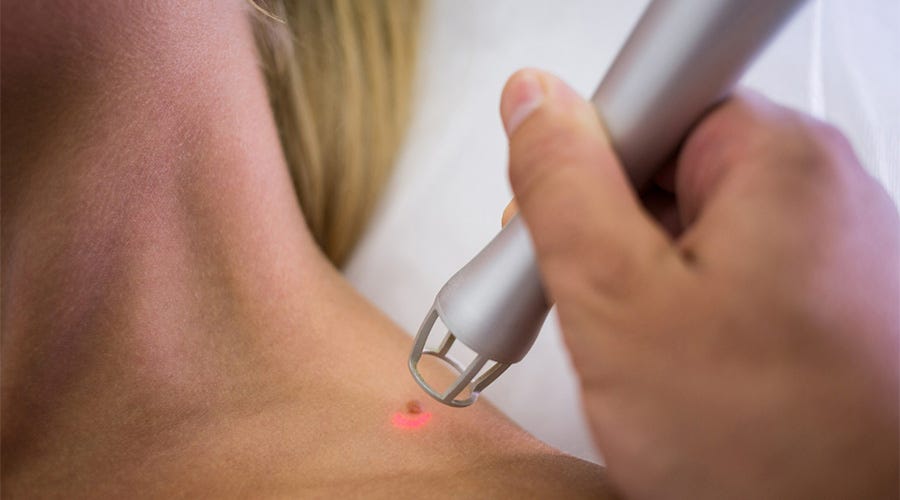Is Skin Tag Removal the Right Treatment for Your Skin?

Strong 8k brings an ultra-HD IPTV experience to your living room and your pocket.
Skin tags are common, benign growths that often appear on areas of the body where skin rubs against skin or clothing, such as the neck, armpits, groin, eyelids, and under the breasts. While these growths are harmless, they can cause discomfort, irritation, or self-consciousness due to their appearance. If you're considering removing a skin tag, it's essential to weigh the pros and cons of treatment, as well as understand the different methods available. This article explores the considerations and options for Skin Tag Removal Dubai, helping you decide whether it’s the right treatment for your skin.
What Are Skin Tags?
Skin tags, also known as acrochordons, are small, soft, skin-colored growths that typically range from a few millimeters to a few centimeters in size. They are made up of skin tissue and often have a small stalk (peduncle) connecting them to the skin. These growths are generally harmless, though they can become irritated if they rub against clothing or jewelry, especially in areas with frequent friction.
While the exact cause of skin tags is not always clear, several factors may increase the likelihood of developing them, including:
Friction: Skin tags are more common in areas where skin rubs together, such as the neck, underarms, and groin.
Genetics: A family history of skin tags may increase the chances of developing them.
Obesity: Increased skin folds in overweight individuals may lead to more frequent friction, promoting skin tag formation.
Age: Skin tags are more common in adults, particularly those over the age of 50.
Hormonal Changes: Pregnancy or certain medical conditions can also cause an increase in skin tags due to hormonal fluctuations.
Should You Remove Your Skin Tags?
While skin tags are not typically a health concern, there are several reasons why someone might want to have them removed. Understanding the benefits and potential drawbacks of removal can help guide your decision.
Reasons to Remove Skin Tags:
Discomfort or Irritation: Skin tags can become irritated if they are in areas where they are subject to constant friction, such as underarms or the neck. This irritation can lead to pain, redness, or inflammation.
Cosmetic Concerns: For many people, skin tags can be unsightly, especially if they are located on visible areas such as the face, neck, or eyelids. Removal may be sought for aesthetic purposes to improve the appearance of the skin.
Preventing Further Growth: Some people prefer to have skin tags removed to prevent them from growing larger or multiplying. Skin tags do not typically grow into a more serious condition, but multiple skin tags can appear over time.
When You Might Choose Not to Remove Skin Tags:
No Symptoms or Discomfort: If your skin tags are not causing any irritation or discomfort, you may choose to leave them in place. As mentioned, they are benign and pose no significant health risk.
Medical Concerns: If you're unsure whether a skin tag is truly benign or if it's a new growth, it's important to consult with a healthcare provider. In rare cases, skin tags may be confused with other types of growths, such as moles or cysts, which may require different treatment.
Methods of Skin Tag Removal:
If you decide that skin tag removal is the best option for you, there are several methods available. Each option varies in terms of cost, recovery time, and effectiveness. Here are some of the most common methods for removing skin tags:
Cryotherapy (Freezing):
Cryotherapy is a popular method for removing skin tags, which involves freezing the growth using liquid nitrogen. The extreme cold destroys the tissue, causing the skin tag to fall off after a few days. This method is often performed in a dermatologist's office and is quick and effective. However, cryotherapy may cause mild discomfort or blistering in some cases.
Pros:
Quick and effective.
Minimal scarring.
Cons:
May cause mild pain or swelling.
Can result in temporary discoloration or blistering of the skin.
Excision (Cutting):
Excision involves cutting the skin tag off using sterile scissors or a scalpel. This method is typically performed by a healthcare provider under local anesthesia to minimize pain. Excision is highly effective and results in immediate removal of the skin tag.
Pros:
Immediate and precise removal.
Low risk of recurrence.
Cons:
Risk of scarring.
Slight pain or discomfort during the procedure.
Cauterization (Burning):
Cauterization uses heat to burn off the Skin Tag Remoal in Dubai. This procedure is performed by a doctor and may be done with a specialized device that delivers controlled heat to the growth. The procedure is quick, and the skin tag falls off after the treated area heals.
Pros:
Effective for larger skin tags.
Minimal bleeding during the procedure.
Cons:
Risk of scarring or burns if not done correctly.
May require local anesthesia.
Over-the-Counter Treatments:
There are various over-the-counter products available for home use that claim to remove skin tags. These products typically involve applying a solution to the skin tag to dry it out, causing it to fall off eventually. However, these treatments can take longer and may not be as effective as professional methods.
Pros:
Convenient and cost-effective.
Can be done at home.
Cons:
Longer treatment time.
Risk of skin irritation if not used properly.
Natural Remedies:
Some people turn to natural remedies such as tea tree oil, apple cider vinegar, or garlic to remove skin tags. While these methods have anecdotal support, there is limited scientific evidence to back up their effectiveness. Additionally, using these remedies can sometimes cause skin irritation or allergic reactions.
Pros:
Natural and inexpensive.
No need for professional intervention.
Cons:
Limited scientific evidence of effectiveness.
Risk of skin irritation or infection.
Post-Removal Care
After having a skin tag removed, it's essential to follow proper aftercare to ensure optimal healing and prevent infection. Here are some general tips:
Keep the area clean and dry.
Avoid picking at the wound to minimize the risk of infection or scarring.
Apply any ointments or creams recommended by your doctor to promote healing.
Protect the area from excessive sun exposure, as this can cause pigmentation changes or scarring.
Conclusion:
If you have a skin tag that is causing discomfort, cosmetic concerns, or irritation, removal may be a worthwhile option. However, if your skin tag is not bothering you and there are no health concerns, leaving it alone is perfectly acceptable. It's always a good idea to consult with a dermatologist or healthcare provider to determine the most appropriate treatment for your individual situation. Ultimately, the decision to remove a skin tag should be based on your personal preferences, symptoms, and the advice of a medical professional.
Note: IndiBlogHub features both user-submitted and editorial content. We do not verify third-party contributions. Read our Disclaimer and Privacy Policyfor details.







